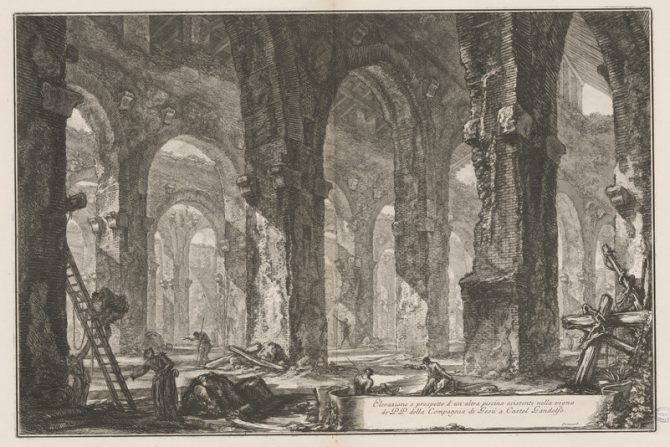This is a blog post written by Karen Shafts, Curator of Prints.
This year we celebrate the three-hundredth anniversary of the birth of the Italian archaeologist, architect, painter, and printmaker Giovanni Battista Piranesi.
Born near Venice on October 4, 1720, Piranesi was trained as an architect, a painter, and a printmaker. However, he is best known for his many series of prints that record the architectural ruins of the Roman Empire.
Working as an artist in Rome, Piranesi was fascinated by the ancient architectural ruins that were located throughout the city and studied them carefully. Using his training as an architect, he was able to draw their structures. His skill as an etcher and an engraver allowed him to create images full of atmosphere and mystery that sparked the imaginations of his viewers.

During Piranesi’s lifetime, Rome was a major stop on the Grand Tour. The Tour was an educational trip undertaken by wealthy young gentlemen to complete their educations. Those on the Tour went to Rome to learn more about the history and culture of earlier Roman civilization and to see the ruins that were being discovered. Many tourists purchased Piranesi’s prints to take home as souvenirs and as examples of their increased knowledge.

I find Piranesi’s prints as fascinating today, as did those 18th century tourists. On first look, the images appear to be accurate architectural records. However, looking closer, one discovers figures and objects that Piranesi created from his own imagination. Who are those people? Why are they there, and what are they doing? How did the columns, vases, and tablets lying about get there? Where did they originally belong? Every time I look at Piranesi’s prints I discover something new, and those questions come to mind. Piranesi’s prints speak to us because we are interested in the past and in what life was like for those who lived before us. I can only imagine the excitement each time a new ruin was discovered!
![Ruins of an ancient tomb in the form of a septizonium [ornamental colonnaded building] on the Appian Way near the villa of Pompey the Great, now outside Albano to the west. Print by Giovanni Battista Piranesi](https://d4804za1f1gw.cloudfront.net/wp-content/uploads/sites/30/2020/11/piranesi-e1606165141999-670x316.png)
Although there is no substitute for viewing Piranesi’s prints in person, the digitization software used to post the images on the Digital Commonwealth provides a unique opportunity for the viewer to examine the prints more closely. If you go to the BPL's page on Digital Commonwealth and click on the Piranesi icon, you can access a print that is of interest and double click on it for a full screen view. By clicking on the full screen view you then are able to zoom in on specific areas to study Piranesi’s technique and the images that he has included more closely. I think that when you are able to examine the prints in such detail you come away with a greater appreciation of Piranesi‘s artistic genius.
To learn more about Piranesi and to view the images available online to date, please visit www.digitalcommonwealth.org.


Add a comment to: Celebrating Giovanni Battista Piranesi (1720-1778) – archaeologist, architect, painter & printmaker